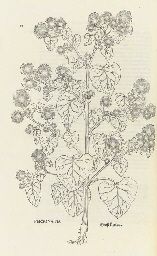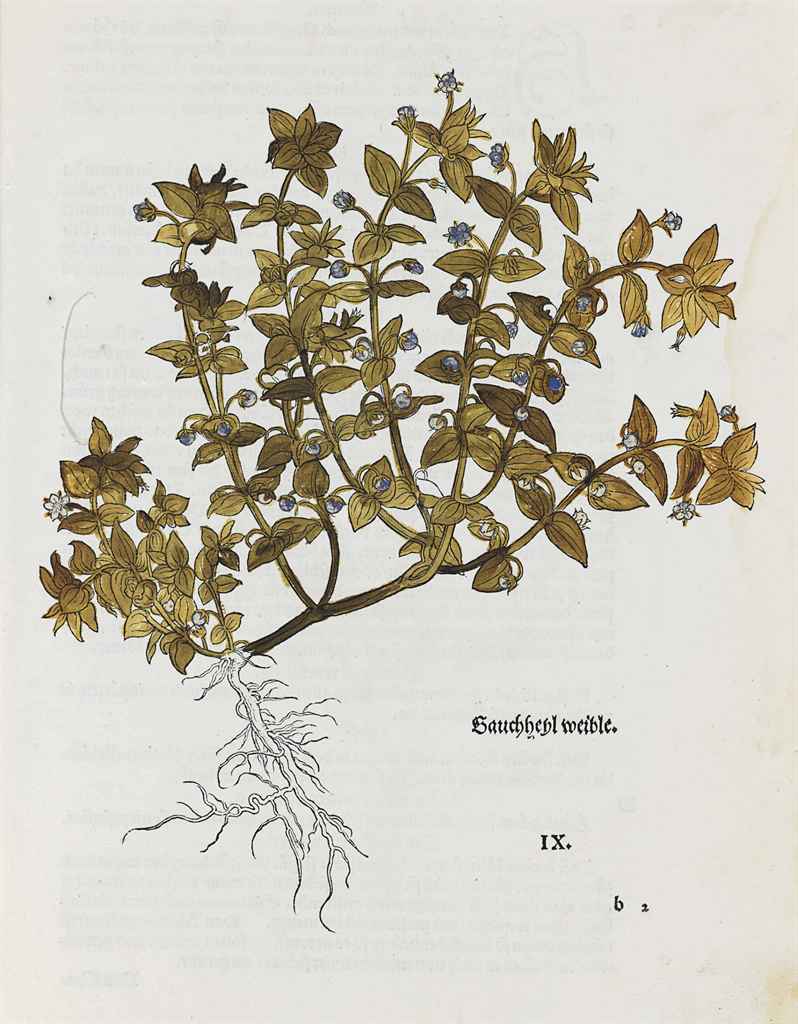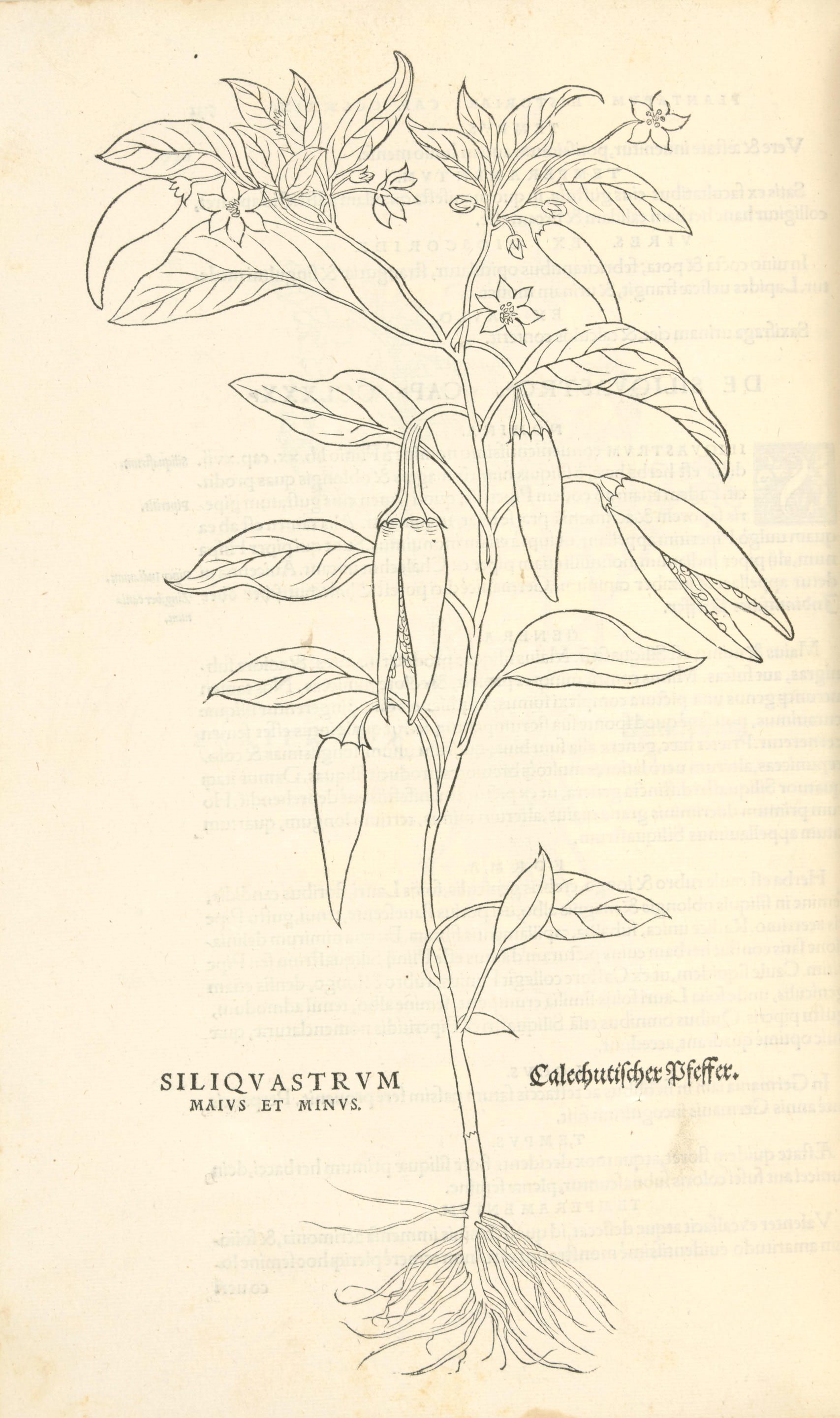Details
FUCHS, Leonhard (1501-1566).
Historia Stirpium Commentarii insignes. Basel: Officina Isingriniana, 1542.
First edition, fully coloured, of ‘perhaps the most celebrated and most beautiful herbal ever published’ (PMM), showing active engagement with the text over several centuries. While it is not unusual for herbals in general to be annotated with identifying captions in the vernacular, the annotations in the present copy are particularly rich. The earliest are those concerning the excerpts from Pliny; they identify the book and chapter number in Pliny’s full text of the Natural History and correct the text against a Froben edition. The Froben press at Basel printed editions of Pliny in 1525, 1530 and 1535 which contain the additional text cited here. Another annotation makes clear that the book was in the hands of someone at the medical faculty at Paris in the 17th century, naming François Leaulté, possibly a forebear of Urbain Leaulté, director of the medical faculty in the next century. Although many copies survive uncoloured, colouring is integral to the text and is specified in several instances. Cf. Arber, ‘The colouring of sixteenth-century herbals’, Nature, 145, 1940.
Fuchs, along with Otto Brunfels and Hieronymous Bock, was one of the three German fathers of modern botany. While his main objective in writing the present work remained in the tradition of Dioscorides and subsequent herbals, describing plants for their medicinal use, Fuchs also gives accurate botanical descriptions of more than 500 plants, including 100 foreign plants, such as the first description of several recently-discovered American plants: maize, pumpkin, chili pepper, and snap bean. The detailed plant-portraits were highly influential. They were drawn from life, largely based on plants in Fuchs' garden at Tübingen, by Albert Meyer, transferred to the woodblock by Heinrich Füllmaurer and cut into the wood by Viet Rudolph Speckle. Portraits of the artists appear at the end of the book. The woodblocks were reused in later editions of Fuchs's herbal, successfully compressed in the smaller-format editions, copied in the works of Bock, Dodoens, William Turner and others, and pirated in contemporary botanical works. Fuchs was ‘the first of the modern era to attempt to give a botanical glossary of terms, presenting it in an alphabetical order’ (Hunt), and he is the oldest source to be cited by Linnaeus in his ground-breaking Species plantarum, and several plant names conferred by Fuchs are retained today. Adams F-1099; Davies, Murray German 175; Grolier/Norman 17; Hunt 48; Nissen BBI 658; PMM 69; Pritzel 3138.
Folio (375 x 237mm). Greek, roman and italic types. 509 full-page botanical woodcuts, 3 smaller cuts in the text, by Veit Rudolph Speckle after Heinrich Füllmauer and Albert Meyer, full-page full-length portrait of Fuchs on title verso, portraits of the 3 artists on fff5r, printer's device on title, repeated on final verso, all woodcuts fully coloured by a contemporary hand, historiated initials, also coloured, in several sizes (title repairs, most marginal, first quire rehinged, neat marginal tear in 3 leaves, very occasional light spotting or faint dampstain).) Austrian 18th-century blindstamped pigskin over wooden boards, arms of the Carthusian monastery at Mauerbach on back cover, spine lettered in ink, two fore-edge clasps, red edges (lettering worn, a little rubbed, endleaves renewed); modern black morocco-backed box. Provenance: plants captioned in several hands of the 16th-18th centuries, one contemporary hand collating the text again a Froben edition (see below), and another hand in French (a few just shaved) – one 17th-century inscription naming François Leaulté and the medical faculty at the University of Paris (fo. 147) – Mauerbach, near Vienna, Carthusian monastery (binding).
Special notice
No VAT on hammer price or buyer's premium.
Details
FUCHS, Leonhard (1501-1566).
Historia Stirpium Commentarii insignes. Basel: Officina Isingriniana, 1542.
First edition, fully coloured, of ‘perhaps the most celebrated and most beautiful herbal ever published’ (PMM), showing active engagement with the text over several centuries. While it is not unusual for herbals in general to be annotated with identifying captions in the vernacular, the annotations in the present copy are particularly rich. The earliest are those concerning the excerpts from Pliny; they identify the book and chapter number in Pliny’s full text of the Natural History and correct the text against a Froben edition. The Froben press at Basel printed editions of Pliny in 1525, 1530 and 1535 which contain the additional text cited here. Another annotation makes clear that the book was in the hands of someone at the medical faculty at Paris in the 17th century, naming François Leaulté, possibly a forebear of Urbain Leaulté, director of the medical faculty in the next century. Although many copies survive uncoloured, colouring is integral to the text and is specified in several instances. Cf. Arber, ‘The colouring of sixteenth-century herbals’, Nature, 145, 1940.
Fuchs, along with Otto Brunfels and Hieronymous Bock, was one of the three German fathers of modern botany. While his main objective in writing the present work remained in the tradition of Dioscorides and subsequent herbals, describing plants for their medicinal use, Fuchs also gives accurate botanical descriptions of more than 500 plants, including 100 foreign plants, such as the first description of several recently-discovered American plants: maize, pumpkin, chili pepper, and snap bean. The detailed plant-portraits were highly influential. They were drawn from life, largely based on plants in Fuchs' garden at Tübingen, by Albert Meyer, transferred to the woodblock by Heinrich Füllmaurer and cut into the wood by Viet Rudolph Speckle. Portraits of the artists appear at the end of the book. The woodblocks were reused in later editions of Fuchs's herbal, successfully compressed in the smaller-format editions, copied in the works of Bock, Dodoens, William Turner and others, and pirated in contemporary botanical works. Fuchs was ‘the first of the modern era to attempt to give a botanical glossary of terms, presenting it in an alphabetical order’ (Hunt), and he is the oldest source to be cited by Linnaeus in his ground-breaking Species plantarum, and several plant names conferred by Fuchs are retained today. Adams F-1099; Davies, Murray German 175; Grolier/Norman 17; Hunt 48; Nissen BBI 658; PMM 69; Pritzel 3138.
Folio (375 x 237mm). Greek, roman and italic types. 509 full-page botanical woodcuts, 3 smaller cuts in the text, by Veit Rudolph Speckle after Heinrich Füllmauer and Albert Meyer, full-page full-length portrait of Fuchs on title verso, portraits of the 3 artists on fff5r, printer's device on title, repeated on final verso, all woodcuts fully coloured by a contemporary hand, historiated initials, also coloured, in several sizes (title repairs, most marginal, first quire rehinged, neat marginal tear in 3 leaves, very occasional light spotting or faint dampstain).) Austrian 18th-century blindstamped pigskin over wooden boards, arms of the Carthusian monastery at Mauerbach on back cover, spine lettered in ink, two fore-edge clasps, red edges (lettering worn, a little rubbed, endleaves renewed); modern black morocco-backed box. Provenance: plants captioned in several hands of the 16th-18th centuries, one contemporary hand collating the text again a Froben edition (see below), and another hand in French (a few just shaved) – one 17th-century inscription naming François Leaulté and the medical faculty at the University of Paris (fo. 147) – Mauerbach, near Vienna, Carthusian monastery (binding).
Special notice
No VAT on hammer price or buyer's premium.



.jpg)


.jpg)

.jpg)






Try LotSearch and its premium features for 7 days - without any costs!
Be notified automatically about new items in upcoming auctions.
Create an alert